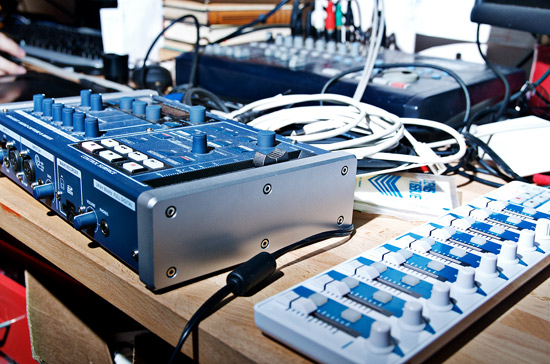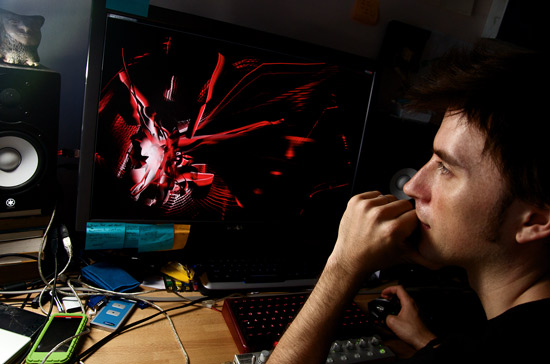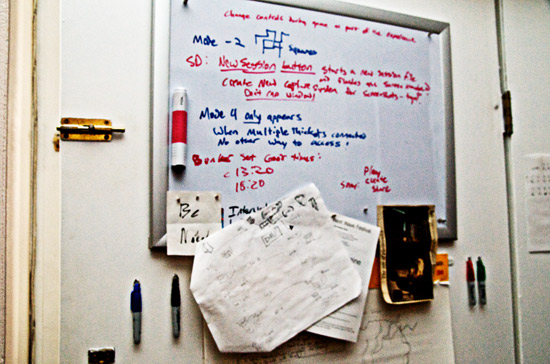This week’s featured artist is an extended interview focusing on the work of multi-media visual artist Joshue Ott.
Joshue Ott is one of those innovative artists who visualizes new media in a broader spectrum. Having created superDraw, a platform in which he customized to become his visual instrument, along with multiDraw and Thicket, both interactive projects, Josh is constantly at the forefront. Working with soundscapes, his distinct style of visuals experiments with the basic qualities of form, texture and movement. Since 2005 Josh has been creating live visuals for numerous musicians and various performances around the world. I first experienced Josh’s work live at the 2010 Unsound Festival in New York. We had this conversation in his studio in Brooklyn where he lives with his wife and two children.
Helen Homan Wu: Okay, let’s talk about how you started superDraw. How long ago was it?
Joshue Ott: It was…years ago. Morgan Packard and Ezekiel Honig released Early Morning Migration and I played at the release party. It was some sort of debut. The first time I did superDraw live in front of people and called it superDraw.
H: So that’s when you started interaction or interactive art?
J: I was a Flash developer initially. I went to art school, graduated and got a job doing video compositing and that turned into Flash development. Flash was a fantastic tool for me because it combined animation, sound and movement, and programming. And I really got sucked into, fell in love with, the programming aspect of it. Someone described it as legos, that lego feeling of when you play with legos, you put legos together and make things. Flash is a lot like that. The amount of creativity, things that you could do with it are really fantastic. So I became a Flash developer and that’s what I was doing when all this (superDraw) began. I was experimenting with it and trying things out and one of the early things that I did was a little drawing, I think I might still have it…
J: Anyway, the initial superDraw was dinky line drawing experiments. SuperDraw’s first version was really made in Flash. And I only performed that version at Share, which is a weekly electro-acoustic jam thing. It’s still going on. Anybody can go and show work and play music together. Visualists can go but it’s harder for them to put things up at the same time so it’s usually passing around the VGA connection for the projector. It became like a socializing thing as well. Morgan and I have gone to other performances together with all kinds of weird bad music, some good and some abstract weird stuff. I started getting inspired by some of the awful bad stuff that I was seeing and hearing, and thinking Oh I could do something cool and interesting too. We went to Share together a couple of times and got inspired as well. It’s a cool environment because it fosters the kind of attitude that you could also come and do it too, so it was encouraging. I actually whipped up something in Flash and performed there a couple of times. When Zeke and Morgan had this release party, I made a much more concerned effort. That’s when I switched over to Processing, which is another programming language.
H: Processing? Is that a different platform?
J: Not Flash, basically. I switched to a different platform.
H: I’m not technically savvy at all, so you’ll have to explain all this (language) to me.
J: In most programming languages, if you have a variable…hmm, how do I explain it simply and not take an hour. The programming language is C so basically if C was 0 and the next line of code is + +, C would become 1. So the programming language C++ is basically saying you’ve just incremented C language and made it 1 better. And C++ is really an object-oriented version of C. C is non-object oriented.
H: It’s very poetic.
J: Funny that you say that, but that was the very first moment I was inspired. When my programming teacher started writing the code on the whiteboard and I looked at it and thought structurally it’s actually kind of pretty and that’s when I thought to myself, wow it’s almost poetic the way this is and the way this looks.
H: What you’re doing is also really basic or pure and that’s the beauty of it.
J: This became my artistic expression and I really enjoy it. I think as a creator I normally get bored with things really quickly and with this, whenever I get bored of it I would change it and add something new to it or…
H: Because you can just manipulate the language?
J: Right. So the way it works is that I have the main program that draws lines basically and I also have these extra algorithms that I can run on the line to make it do various things, so that I can make it bounce like there’s gravity or something or I can make it twist or do interesting things, or I can do both of those at the same time. So that’s what I do, I combine all these colors and flavors and things and use that to express myself. I have complete control over what it’s doing.
H: And it’s so original because you are the author. So basically nobody can copy you.
J: Well! That’s not true. There are a lot of very technologically literate artists coming into the universe of creation right now and this is not that hard to do. Even what I’ve done is not that difficult. I think what really sets me apart is the movement, the focus on animation, whereas most people focus on how something looks or is composed because they come from video art backgrounds. I’m actually more interested in how it moves. I actually originally made this program with the idea that my wife would do live contour drawing while I made music for her, and in my head we were going to form this little band but she wasn’t into it. So it started to move further and further away from being about drawing to being about these effects that I was drawing or making to do all kinds of different things. That was the progression and in the years I just added more and more to it. I kept adding features and the multi-user stuff. Where I’m at now…I’m going in a whole bunch of different directions.
H: Do you still go to Share?
J: I have, actually. I was going to Share fairly often last year to work with Eric Redlinger who wrote the Murmur (Mmr) program, which is what people are using for the multi-user connection to superDraw. He actually wrote that on the iPhone. You can apply that to anything and it’s free. He was also part of the gallery show that I did recently, the Multi-user art show in Brooklyn (Devotion Gallery). Every piece (iphone) used the Mmr technology to engage with the audience and basically connect with the art. And there were four different pieces, so that was a cool thing.
H: I noticed you put a lot of screen shots of your animations on your site. That changes the whole dynamic of it.
J: Absolutely. It’s totally different. I was happy with them, but they’re also very old. And the idea was to use superDraw in a different way, instead of making moving images but into still images. I used this technique for album covers, and I can show you…here’s the 2008 album cover.
H: Who is this artist?
J: Ryan Lott or Son Lux. He’s a pop artist, well not really a “pop” artist, he’s a number of things, but he released an album that’s on the “pop” side of things. So he found me and liked my work and contacted me to do an album cover. Oh and this is another album cover (he finds another album under a stack) which is for one of my other collaborators Morgan Packard. He released an album of electronic music and we released together a DVD of his music with superDraw’s work. It’s really old and early work of that stuff, but it’s still like a history of it.
H: It’s nice. And it’s Anticipate.
J: Yeah, it’s Zeke’s (Ezekiel Honig) label.
H: What are you working on now? Any recent projects?
J: This thing for Anna Clyne, I made two different videos for her. They both use the same technique and it’s the same that I use for the multiDraw stuff. You saw that at Gina’s (Gina Gibney Dance Company) performance.
H: I could see Apple commissioning you to do something.
J: That’ll be great. I’m also about to develop something new for the iPhone. I showed you Thicket right? Well it’s the same thing as superDraw where what you see is the actual interface, there are no sliders or things like that. And people are complaining that there are no controls. People are use to apps with a bunch of sliders, knobs and things that you can control aspects of the program. People are requesting that.
H: Right. That’s why I was surprised and I asked you where is the interface to superDraw?
J: There is none.
(I’m playing around with Thicket, magnetizing the iPad’s touchscreen with my fingers and palm.)
J: So this is what I’m moving forward with at this point. I actually want to make superDraw for the iPad. And one reason is that you can actually plug in an adaptor to go onto an external screen. So people can use this device to make visuals.
H: Is this a beta?
J: No, this is out on the app store, you can buy this. So this capability makes me really excited as a visualist. The next thing that I’m going to do is some mixture of superDraw with something like Thicket but not just on the iPad but on the iPhone as well.
H: But not for the internet?
J: No. I mean it could, I don’t see a reason why it couldn’t, but it’s much more spectacular on the iPad.
H: I know. But I don’t have either of these! I guess I should get an iPod Touch or something. There’s so many fun apps out, it’s like a whole movement going on right now.
J: Yes, absolutely! And I’m really excited about it.
H: What are some of the other visual art apps that you like?
J: Well, the Brian Eno one is pretty awesome.
(We test that one out. Beautiful. He shows me a few more including an app by Record Makers.)
J: I’m also more interested to make something that crosses the boundaries between game and art. Have you seen the Sonic Wire Sculptor?
(He shows me this drawing and music app that is not unlike the Etch-a-Sketch)
J: I can spend hours showing you stuff.
H: Do you let your kids use superDraw?
J: Yeah. I can show you Orli’s house. (His daughter made a doodle mimicking daddy’s superDraw drawing on the walls of a life-size cardboard box house handmade by Josh.)
Helen Homan Wu is a curator and writer. She lives and works in Brooklyn, NY.
Photo credits: 1 (courtesy Joshue Ott), 2 (taken at Mutek by Caroline Hayeur), 3, 4, 5, 7 (Rebecca Black), 6 (HW)
Joshue Ott’s work and live performances can be found on
intervalstudios.com
More information about Thicket here.








 RSS
RSS
